Taking Care of Our Own 2022
|
|
|
|||||||||||||||||||||||||
|
|
|
|
|
|
|||||||||||||||||||||||||
|
|
|
|
|
Limited options for professional growth and the lack of a clear career path are barriers to recruitment, retention and career longevity.
The EMS Burnout Repair Kit series, presented by EMS1 and Zoll, equips individuals at all levels in EMS with tools for dealing with the primary sources of burnout, helping them emerge as better, happier providers and more complete people.
In this installment, a panel comprised of individuals representing different career paths in EMS and leaders from progressive agencies will discuss resources for career advancement and resiliency, how to find the path that is right for you, and how agencies can support providers in advancing their careers.
Join the live discussion, March 1 at 1 p.m. CT
Carly Alley
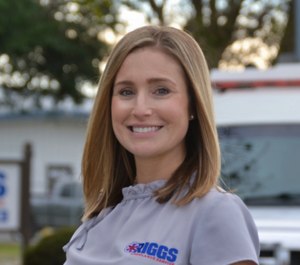
Carly Alley is the executive director for Riggs Ambulance Service in Merced, California. Earlier in her career, Alley served as a firefighter-EMT in the U.S. Forest Service while earning her paramedic certification. After being hired by Riggs, she transitioned to the agency’s tactical EMS program, where she spent 10 years as the team leader before moving into administration.
Michael Fraley, BS, BA, NRP
-166fe.jpg)
Michael Fraley has over 25 years of experience in EMS in a wide range of roles, including flight paramedic, EMS coordinator, service director and educator. Fraley began his career in EMS while earning a bachelor’s degree at Texas A&M University. He also earned a BA in business administration from Lakeland College.
When not working as a paramedic or the coordinator of a regional trauma advisory council, Michael serves as a public safety diver and SCUBA instructor in northern Wisconsin.
John (JP) Peterson, MS, MBA
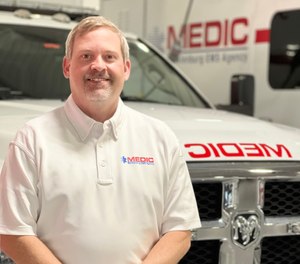
JP Peterson is the newly appointed executive director at Mecklenburg EMS Agency (MEDIC) in Charlotte, North Carolina. He started his career as an EMT in Chicago in 2000 and most recently served as vice president of Florida operations for PatientCare EMS Solutions.
He is licensed as a paramedic in Florida and North Carolina, and holds National Board Certification as an occupational therapist. He has completed Six Sigma Yellow Belt certification and is a graduate of the American Ambulance Association, Ambulance Service Manager Course. JP received the Pinellas County Commissioner, John Morroni Award for first responders in 2013.
JP is a past president of the Florida Ambulance Association. He is a member of the North Carolina Association of EMS Administrators as well as the AAA Bylaws, Professional Standards and Ethics committees.
The winners of the 2021 AAA Board of Directors election are listed below. The term for each position will begin on January 1, 2022. In compliance with our updated association bylaws, the candidate who received the most votes in each region will serve a one-time three year term and the candidate with the second most votes will serve a two-year term. Please join us in thanking all candidates for their service to the American Ambulance Association.
Allyson Pharr
Acadian Ambulance
Scott Mickelsen
Bell Ambulance, Inc.
Speaker: Scott Moore, Esq. | Share on Facebook
This funding opportunity will distribute $25.5 billion in additional Phase 4 General Distribution for EMS agencies and American Rescue Plan (ARP) payments for qualified rural providers who furnish services to Medicaid/CHIP and Medicare beneficiaries. It is critical for all #EMS providers to apply for this funding opportunity regardless of previous funding allocations. We have learned that many EMS providers did not apply for the Tranche 3 funding opportunity because they did not believe that they would be eligible to receive funds under the announced funding formula. Due to the limited number of applicants in Tranche 3, HRSA modified the formula and many who failed to apply would have received funds. We are recommending that all EMS agencies apply to receive the funding that they desperately need. The deadline for applying is 11:59 p.m. on October 26, 2021. There is no penalty for applying.
From the Journal of the American College of Emergency Physicians
Emergency medical services education research priorities during COVID-19: A modified Delphi study
Rebecca E. Cash PhD, MPH, William J. Leggio EdD, Jonathan R. Powell MPA, Kim D. McKenna PhD, Paul Rosenberger EdD, Elliot Carhart EdD, Adrienne Kramer PhD, Juan A. March MD, Ashish R. Panchal MD, PhD, for the Pandemic Educational Effects Task Force
Our objective was to identify research priorities to understand the impact of COVID-19 on initial emergency medical services (EMS) education.
We used a modified Delphi method with an expert panel (n = 15) of EMS stakeholders to develop consensus on the research priorities that are most important and feasible to understand the impact of the COVID-19 pandemic on initial EMS education. Data were collected from August 2020 to February 2021 over 5 rounds (3 electronic surveys and 2 live virtual meetings). In Round 1, participants submitted research priorities over 9 specific areas. Responses were thematically analyzed to develop a list of research priorities reviewed in Round 2. In Round 3, participants rated the priorities by importance and feasibility, with a weighted score (2/3*importance+1/3*feasibility) used for preliminary prioritization. In Round 4, participants ranked the priorities. In Round 5, participants provided their agreement or disagreement with the group’s consensus of the top 8 research priorities.
During Rounds 1 and 2, 135 ideas were submitted by the panel, leading to a preliminary list of 27 research priorities after thematic analysis. The top 4 research priorities identified by the expert panel were prehospital internship access, impact of lack of field and clinical experience, student health and safety, and EMS education program availability and accessibility. Consensus was reached with 10/11 (91%) participants in Round 5 agreeing.
The identified research priorities are an important first step to begin evaluating the EMS educational infrastructure, processes, and outcomes that were affected or threatened through the pandemic.
Flipping OFF the Switch on HOT Emergency Medical Vehicle Responses!
Recorded July 7, 2021 | 14:00–15:15 pm ET | FREE Webinar
Download Slide Deck | Watch on YouTube
HOT (red light and siren) responses put EMS providers and the public at significant risk. Studies have demonstrated that the time saved during this mode of vehicle operation and that reducing HOT responses enhances safety of personnel, with little to no impact on patient outcomes. Some agencies have ‘dabbled’ with responding COLD (without lights and sirens) to some calls, but perhaps none as dramatic as Niagara Region EMS in Ontario, Canada – who successfully flipped their HOT responses to a mere 10% of their 911 calls! Why did they do it? How did they do it? What has been the community response? What has been the response from their workforce? Has there been any difference in patient outcomes? Join Niagara Region EMS to learn the answers to these questions and more. Panelists from co-hosting associations will participate to share their perspectives on this important EMS safety issue!
Kevin Smith, BAppB:ES, CMM III, ACP, CEMC
Chief
Niagara Emergency Medical Services
Jon R. Krohmer, MD, FACEP, FAEMS
Director, Office of EMS
National Highway Traffic Safety Administration
Team Lead, COVID-19 EMS/Prehospital Team
Douglas F. Kupas, MD, EMT-P, FAEMS, FACEP
Medical Director, NAEMT
Medical Director, Geisinger EMS
Matt Zavadsky, MS-HSA, NREMT
Chief Strategic Integration Officer
MedStar Mobile Integrated Healthcare
Bryan R. Wilson, MD, NRP, FAAEM
Assistant Professor of Emergency Medicine
St. Luke’s University Health Network
Medical Director, City of Bethlehem EMS
Robert McClintock
Director of Fire & EMS Operations
Technical Assistance and Information Resources
International Association of Fire Fighters
Mike McEvoy, PhD, NRP, RN, CCRN
Chair – EMS Section Board – International Association of Fire Chiefs
EMS Coordinator – Saratoga County, New York
Chief Medical Officer – West Crescent Fire Department
Professional Development Coordinator – Clifton Park & Halfmoon EMS
Cardiovascular ICU Nurse Clinician – Albany Medical Center
Ambulance Fleet Tips for Weathering the Chassis Shortage
Webinar | June 23, 2021 | 14:00 ET | Free to AAA Members
The American Ambulance Association and the Commission on Accreditation of Ambulance Services recently reported that a global semiconductor shortage has crippled the production of motor vehicle chassis—including those used by ambulance manufacturers and remounters. Ford Motor Company, which supplies approximately 70% of the ambulance chassis used in the US, halted production in mid-April. The end is not yet in sight, with the shortage of the critically important microchips predicted to run into 2022.
Join ambulance fleet experts from across the country to learn what your EMS agency can do NOW to extend the lifecycle of your vehicles and minimize the impact of the chip and chassis shortage. Additionally, learn how the American Ambulance Association is working to drive federal, state, and local advocacy efforts to ensure that first responders are at the front of the line when production resumes. Don’t miss your chance to learn from ambulance fleet luminaries how they keep their crews rolling, 24/7!
Drew Morrow
Director of Support Services, Pro EMS
Mark Van Arnam
Administrator, CAAS GVS
Maria Bianchi
CEO, American Ambulance Association
Trampus Gaspard
Senior Director of Logistics, Acadian Companies
|
|
|
|

Free Webinar July 7 | 14:00–15:15 ET
HOT (red light and siren) responses put EMS providers and the public at significant risk. Studies have demonstrated that the time saved during this mode of vehicle operation and that reducing HOT responses enhances safety of personnel, with little to no impact on patient outcomes. Some agencies have ‘dabbled’ with responding COLD (without lights and sirens) to some calls, but perhaps none as dramatic as Niagara Region EMS in Ontario, Canada – who successfully flipped their HOT responses to a mere 10% of their 911 calls! Why did they do it? How did they do it? What has been the community response? What has been the response from their workforce? Has there been any difference in patient outcomes? Join Niagara Region EMS to learn the answers to these questions and more. Panelists from co-hosting associations will participate to share their perspectives on this important EMS safety issue!
Kevin Smith, BAppB:ES, CMM III, ACP, CEMC
Chief
Niagara Emergency Medical Services
Jon R. Krohmer, MD, FACEP, FAEMS
Team Lead, COVID-19 EMS/Prehospital Team
Director, Office of EMS
National Highway Traffic Safety Administration
Douglas F. Kupas, MD, EMT-P, FAEMS, FACEP
Medical Director, NAEMT
Medical Director, Geisinger EMS
Matt Zavadsky, MS-HSA, NREMT
Chief Strategic Integration Officer
MedStar Mobile Integrated Healthcare
Bryan R. Wilson, MD, NRP, FAAEM
Assistant Professor of Emergency Medicine
St. Luke’s University Health Network
Medical Director, City of Bethlehem EMS
Robert McClintock
Director of Fire & EMS Operations
Technical Assistance and Information Resources
International Association of Fire Fighters
Mike McEvoy, PhD, NRP, RN, CCRN
Chair – EMS Section Board – International Association of Fire Chiefs
EMS Coordinator – Saratoga County, New York
Chief Medical Officer – West Crescent Fire Department
Professional Development Coordinator – Clifton Park & Halfmoon EMS
Cardiovascular ICU Nurse Clinician – Albany Medical Center
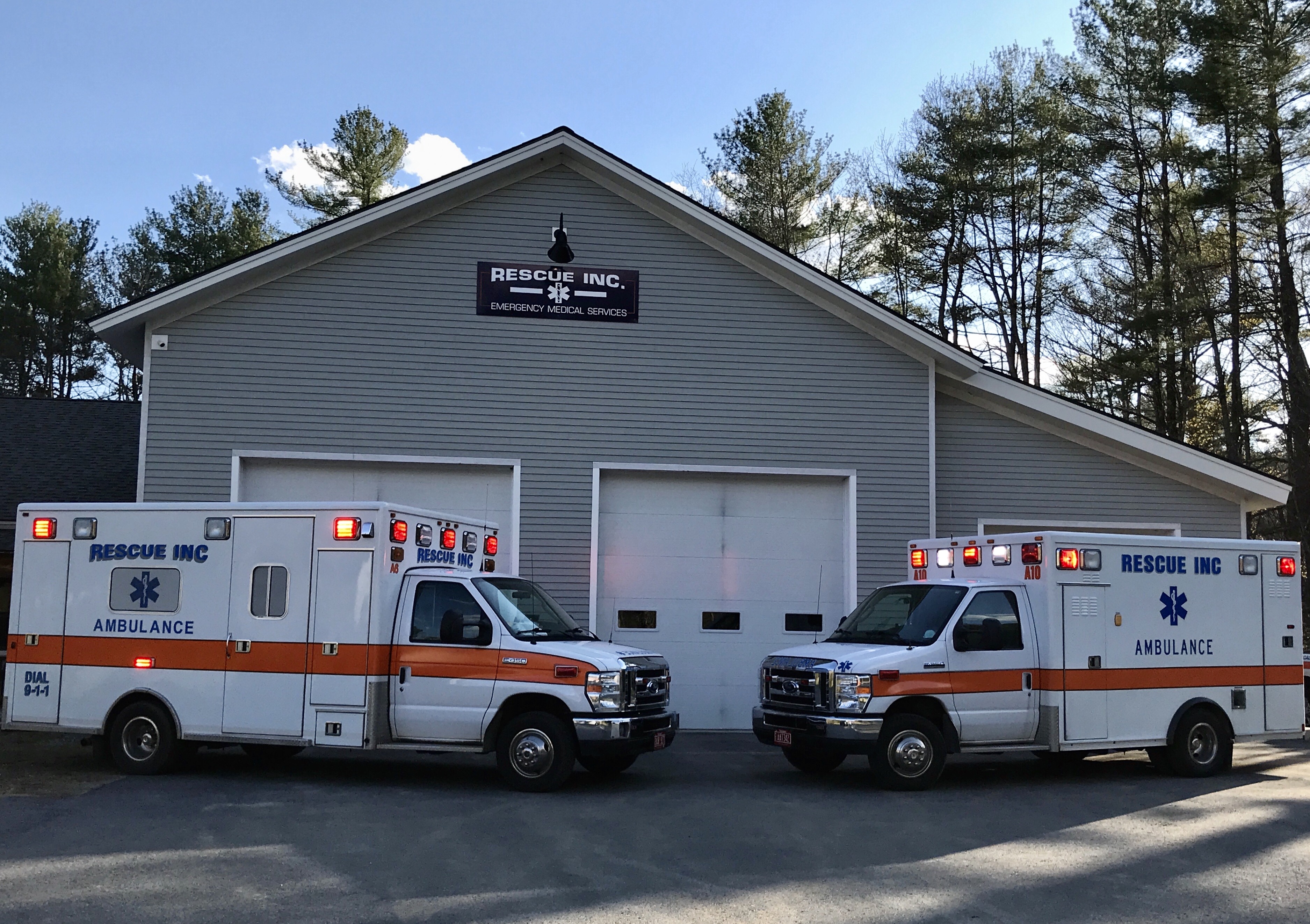 Rescue, Inc.
Rescue, Inc.
Brattleboro, Vermont
Facebook
Rescue Inc is a private non-profit service in Southern Vermont. Founded in 1966 as a volunteer organization responding to local emergency calls, Rescue today is mission-driven; providing emergency medical treatment and transportation, specialized rescue services, community education, and transportation of critical patients between area hospitals. Out of two stations, and with a fleet of 9 ambulances and 3 response vehicles, we provide timely and efficient service in our five hundred square mile coverage area in Southern Vermont and Southwestern New Hampshire.
“EMS week gives us the chance to celebrate and spotlight the care, compassion, and skill our providers tirelessly demonstrate. Through long nights, bad weather, and now pandemics, our health care providers continue to inspire. On behalf of grateful patients and families, I thank you!”
– Drew Hazelton, Chief
 2020 has brought the challenges of COVID-19 and supply line shortages, but also the development of new programs including EMS ultrasound, EMT hybrid courses, and a mobile vaccination program to our community.
2020 has brought the challenges of COVID-19 and supply line shortages, but also the development of new programs including EMS ultrasound, EMT hybrid courses, and a mobile vaccination program to our community.
During the COVID-19 crisis, Rescue Inc stepped in with resources to engage in critical work for public health. In collaboration with the health department, Rescue Inc provided expanded transport capabilities; transporting COVID positive persons to isolation facilities for recovery. Our crew of medical providers staffed pop-up testing sites and have screened thousands. As a way to limit exposure, our providers were called upon to facilitate mobile testing and would travel to test a single person or a whole family in their own homes. Once the vaccine became available, Rescue Inc designed a mobile vaccine trailer and worked with the Vermont Department of Health to facilitate clinics all over the state. In the spirit of our mission, we continue to bring healthcare on the road. We have vaccinated thousands – at schools, restaurants, race tracks, and more.
“EMS providers are educated members of your community that provide prehospital care that saves lives every day. When the tone drops they set aside everything and put themselves into emergency situations to care for those that they value; their community.”
~Lee Bookwalter, EMT
This year our community is feeding us for EMS Week! Breakfast, Lunch, and Dinner for our duty crews are being provided by area restaurants for each day of this special week! Our vaccine trailer will be on the road all week, celebrating EMS by supporting the mission of health and wellness for our community.
“When we are called to a scene, whether it be an MVA, a stroke, or an anxiety attack, we legitimately just want to be there for someone during their time of need. Sometimes that means medical intervention, and sometimes just lending a hand to hold. Long story short, we just have love for people!”
~Zach Gilbeau, EMT“I believe EMS is important because we are always there. No matter what day of the week, time of day, or what your emergency is, we will show up and take care of you.”
~Emily Wilson, Paramedic/Captain
From AIMHI, FirstWatch, and the National EMS Museum | Hosted on Prodigy EMS
|
|
|
|
|
|
|
|
|
|
|
|
|
|
|
|
|
|
|
|
|
|
 Harris County Emergency Corps
Harris County Emergency Corps
Houston, Texas
Facebook
Committed to preserving lives through clinical excellence, progressive medicine, and professional service, Harris County Emergency Corps (HCEC) is a premier EMS agency and the only Commission on Accreditation of Ambulance Services accredited agency with headquarters in Houston. HCEC was the first EMS agency formed in the state of Texas. Serving approximately 400,000 citizens, HECE provides 911 EMS operations in north Houston for Harris County Emergency Services District No. 1. HCEC also provides event medical coverage across Texas, trains clinicians with highly specialized classes, communicates with 11 other agencies through our innovative dispatch center and leads Houston’s first Community Health Paramedic Program.
Our organization changed, I believe, for the better. We overcame obstacles, and our remarkable team worked together like never before. I would like to thank each person involved for your commitment to our organization and the community we serve. I appreciate the work you do each and every day. — Jeremy Hyde, CEO
 Year 2020 was a year like no other. The COVID-19 Pandemic affected every person globally, and we are still living in a world of mask-wearing and sanitizing stations.
Year 2020 was a year like no other. The COVID-19 Pandemic affected every person globally, and we are still living in a world of mask-wearing and sanitizing stations.
Our 9-1-1 call volumes were drastically reduced for the first few months of 2020. Almost immediately, PPE was on a national shortage. HCEC preserved resources and did not suffer any PPE shortage. Employees were never in jeopardy for not having protective equipment. Then COVID infection rates started increasing, which increased our 9-1-1 call volume to exceed any previous record in history.
During the time of significant volume increases, employees got the virus. Other staff stepped up to fill needed roles. Event staff helped fill in additional ambulances for COVID response. Field staff took a place in dispatch to help screen calls. The Dispatch Center and field staff worked together to ensure the calls were made appropriately with the right precautions.
HCEC is hosting a reunion with a Pediatric CPR family, celebrating service awards, hosting a crawfish boil and hosting a blood drive.
“EMS continues to evolve beyond traditional ambulance transport. Not only do we serve as the community’s medical safety net, but we have also begun the transition to true mobile integrated health care. Progressive EMS agencies across the country are now involved with trauma and disease prevention, implementing community paramedic programs, and reducing preventable hospital admissions. EMS is a critical part of our health care system overhaul. We should be proud of where we are and where we are going!
-Corey Naranjo BSN, RN, LP, CP-C“EMS is often the link between poor health and a healthy outcome. It can also quite literally be the difference between death and life of a person.” – Steven Nelson MHA, LP, In-Charge Paramedic,
“EMS is a vital corner of the first responder triangle. As EMS personnel we not only increase the survivability of major incidents, but we also bring knowledge to the public to help all in need.” -Blake King EMT-P, FTO-1, In-Charge Paramedic
 Waterbury Ambulance
Waterbury Ambulance
Waterbury, Vermont
Facebook
Waterbury Ambulance Service was founded in 1971, since then, we’ve grown significantly, but at our core we are still a group of highly skilled, committed volunteers and staff, ready at a moment’s notice to save a life, or just lend a helping hand. We provide 911 coverage to the towns of Waterbury, Duxbury and parts of Moretown, Vermont as well as mutual aid to our neighboring communities. Waterbury Ambulance provide interfacility transfers when we have the staff available. We have two ambulances, 15 advanced EMTs, 19 Emergency Medical Technicians, and four drivers. We also provide CPR, First Aid, Car Seat Fitting and Stop the Bleed Trainings.
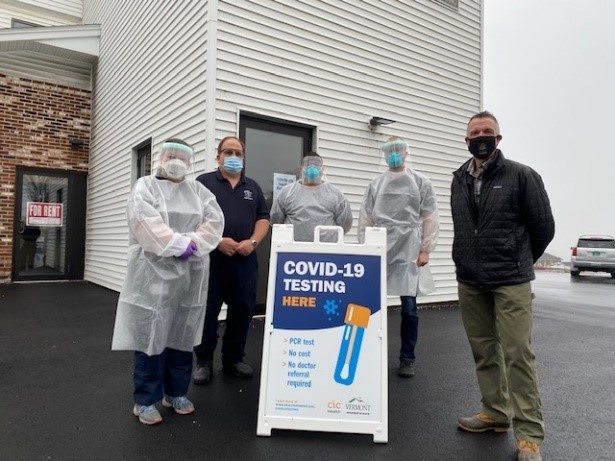 Waterbury Ambulance also supports The Waterbury Backcountry Rescue Team which was founded in 2002, in order to lead the search and rescue of patients injured or lost in areas of Vermont where an ambulance is not able to readily access. Waterbury Backcountry Rescue Team is composed of a specially trained crew of rescuers and EMTs, who locate, extricate, and field treat patients, bringing them to an area which can be accessed by ambulance.
Waterbury Ambulance also supports The Waterbury Backcountry Rescue Team which was founded in 2002, in order to lead the search and rescue of patients injured or lost in areas of Vermont where an ambulance is not able to readily access. Waterbury Backcountry Rescue Team is composed of a specially trained crew of rescuers and EMTs, who locate, extricate, and field treat patients, bringing them to an area which can be accessed by ambulance.
“This year has been a remarkable one. I am inspired by the way Waterbury Ambulance’s Team has stepped up in uncertain times to ensure the safety of themselves and our community”
–Mark Podgwaite, Executive Director
 Covid-19 impacted Waterbury Ambulance by initially creating additional training and safety requirements. The team responded quickly ensuring that we provide the best possible care to our community during a scary time. The State of Vermont reached out to Waterbury Ambulance asking if we could support the state in Covid-19 testing. Waterbury Ambulance rose to the occasion by teaming up with two other ambulance services and a local ski patrol to provide testing 7 days a week at three different locations throughout our region. To date Waterbury Ambulance has provided tens of thousands of Covid-19 tests to the community. Waterbury Ambulance then hit the road providing vaccines to home-bound Vermonters. We have also helped the State of Vermont staff vaccine clinics and National Guard Clinics.
Covid-19 impacted Waterbury Ambulance by initially creating additional training and safety requirements. The team responded quickly ensuring that we provide the best possible care to our community during a scary time. The State of Vermont reached out to Waterbury Ambulance asking if we could support the state in Covid-19 testing. Waterbury Ambulance rose to the occasion by teaming up with two other ambulance services and a local ski patrol to provide testing 7 days a week at three different locations throughout our region. To date Waterbury Ambulance has provided tens of thousands of Covid-19 tests to the community. Waterbury Ambulance then hit the road providing vaccines to home-bound Vermonters. We have also helped the State of Vermont staff vaccine clinics and National Guard Clinics.
“EMS is so vitally important because we provide frontline medical care for our communities of neighbors, family, friends, colleagues and even those we haven’t met yet. We do it 24 hours a day, 7 days a week, 365 days a year. Whether it’s a car crash with injuries, heart attack, overdose, or a pandemic, our communities depend on us to jump in and give the best care possible at any moment’s notice.” -Kristen Hamel, AEMT
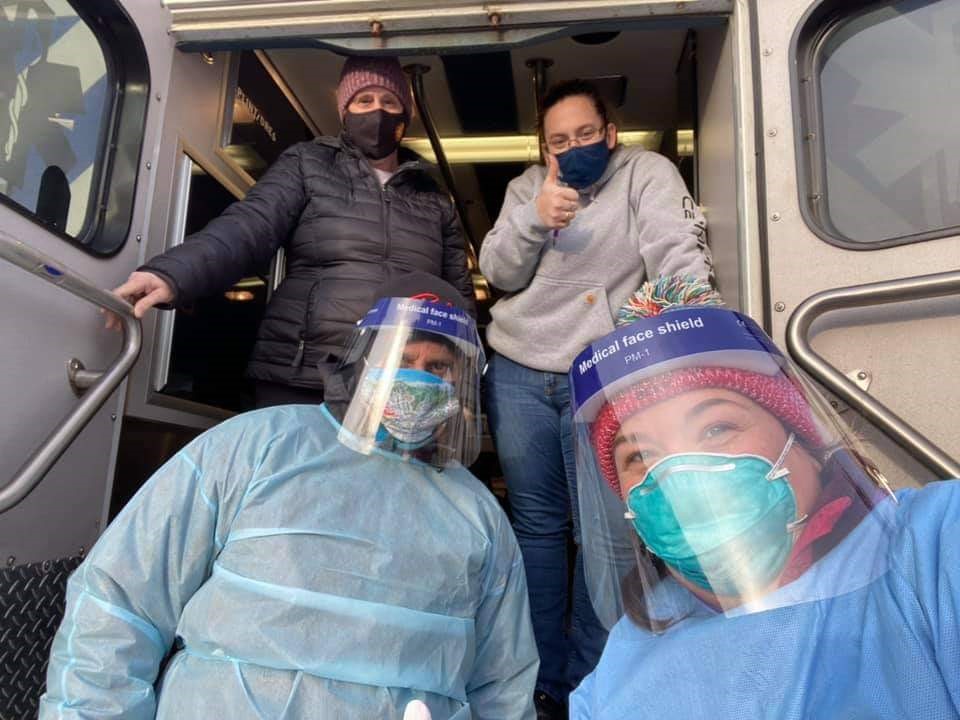 “I believe that EMS is vital because we all need someone in our times of need to be that outside person to be kind, caring, and compassionate to our personal emergencies. Someone to validate our physical & emotional pain/suffering/ distress. Someone who you can trust with your life to get you the care you need, advocative for you, and ease your worries.” -Vicki Fielding, AEMT
“I believe that EMS is vital because we all need someone in our times of need to be that outside person to be kind, caring, and compassionate to our personal emergencies. Someone to validate our physical & emotional pain/suffering/ distress. Someone who you can trust with your life to get you the care you need, advocative for you, and ease your worries.” -Vicki Fielding, AEMT
Waterbury Ambulance is celebrating EMS week by supporting and providing Vaccination clinics around the state, covering 911 calls and providing 7-day a week Covid testing.
“EMS plays a key role into the prevention of death and disease processes in a community. The stronger the EMS organization, the better the community can grow and flourish” -Tom Leeman, AEMT
“EMS is important to me because we as ems providers are a small light at the beginning of a very dark tunnel for some people” -Kayla Reed, Driver/Future EMT
 East Baton Rouge EMS
East Baton Rouge EMS
Baton Rouge, Lousiana
Facebook | Twitter
East Baton Rouge EMS is a municipal service that originated on August 6th, 1982. The Department is funded by a property tax and insurance billing. EBREMS is the primary ALS provider for the parish of East Baton Rouge, Louisiana. Unlike most systems, all 911 calls in the parish are first answered by EBREMS Medics. East Baton Rouge Parish is 456sq/mi and is comprised of the City of Baton Rouge and the towns of Zachary, Baker and Central. With a total population +440,000, East Baton Rouge is the Capitol of the State of Louisiana and is the home of two major Universities.
EBREMS operates 11 EMS stations with 24 ambulances, 20 sprint vehicles, 1 mass casualty unit and 3 ASAP carts. There are 138 Field Medics, 9 Shift supervisors, Division managers, and 32 communications officers. EBREMS responds to approximately 64,000 calls per year. In addition to responding to 911 calls, EBREMS also offers Telemedicine, Event coverage, HAZ-MAT, CISM, Bicycle, and Special Response Teams. A new Bariatric unit has just been purchased along with 16 new ambulances. The new fleet will go into operation in July.
 A response plan to COVID was discussed in March 2020. The first order was to acquire enough PPE for our medics in the field. PPE included P-100 masks, goggles, and isolation kits. Two ambulances were converted into “COVID units” by using plastic sheeting to block the walk-through access of the units and the ALS cabinet. The units were stocked with an abundance of disinfectant and PPE. 12 medics volunteered to work on these units and only respond to COVID-related calls. The intention was to isolate the cab of the truck from the patient compartment, and limit exposure to the rest of the field by only using the assigned medics for these types of calls. 911 Operators began asking COVID screening questions, and would relay the information to the responding unit. Every patient was provided a surgical mask and the use of nebulizers was banned due to the aerosolization.
A response plan to COVID was discussed in March 2020. The first order was to acquire enough PPE for our medics in the field. PPE included P-100 masks, goggles, and isolation kits. Two ambulances were converted into “COVID units” by using plastic sheeting to block the walk-through access of the units and the ALS cabinet. The units were stocked with an abundance of disinfectant and PPE. 12 medics volunteered to work on these units and only respond to COVID-related calls. The intention was to isolate the cab of the truck from the patient compartment, and limit exposure to the rest of the field by only using the assigned medics for these types of calls. 911 Operators began asking COVID screening questions, and would relay the information to the responding unit. Every patient was provided a surgical mask and the use of nebulizers was banned due to the aerosolization.
The Mayor declared a local public health emergency on March 13th. Schools, restaurants, bars, and non-essential businesses were closed and a “stay at home order” was implemented. 911 Operators began to see a surge in calls from the public asking COVID-related questions. This overwhelming number of non-emergent calls led to a Public Service campaign to inform the public not to call 911 for COVID questions. A new 211 number was utilized for these types of calls. Several testing sites opened throughout the parish, including one at the EBREMS Headquarters. Despite a large number of tests given, the percentage of positive tests was only about 7%.
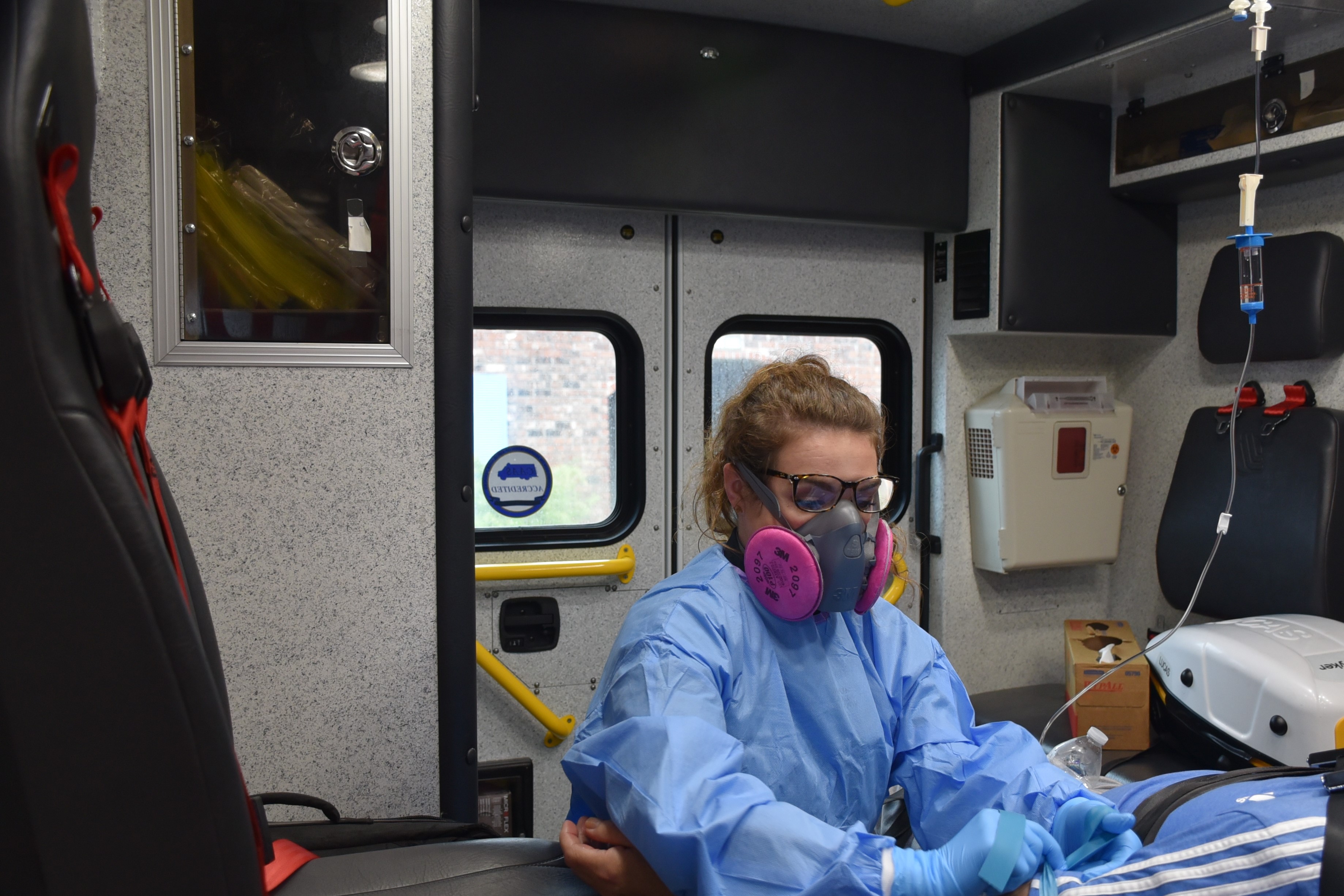
East Baton Rouge lifted the Emergency Declaration in May 2020. Schools remained closed for a while, but offered virtual learning. Restaurants, Bars, Churches and non-essential businesses opened with limited capacity and mandated face mask requirements. Today EBR parish is 100% open, and EMS operation is back to pre-COVID status with the exception of continued use of face masks on every response.
“It is my belief that Baton Rouge EMS has some of the finest medics in the country and you would be hard pressed to find a better group of people to work with. Their dedication and professionalism through this last year’s pandemic has been nothing short of impressive. They care for their patients and their fellow first responders and treat them like family. It is an honor to work with all the medics here in Baton Rouge, and they deserve recognitions for the hard job that they do.”
-Chad Guillot
EMS Director
East Baton Rouge Parish EMS
Every year our Public Information Officers work hard to promote the Department by doing interviews on Morning News shows, Submitting stories to the newspaper, and posting on Social Media. Our Paramedic Association purchases EMS Week gifts for the employees and also funds the annual Award Ceremony that is always held during EMS Week. The Administration Department provides lunch to the crews on each shift, and local hospitals also provide snacks and food at their hospitals for the field medics.
“We are a family-oriented department, and we treat the community like our own”
-Hillary Duncan, Paramedic
“We strive to meet the goals of our mission statement and continually adapt to fulfill the needs of our community”
-Otha Henry, Training Officer
“As EMS providers we value our community”
-Kerri Avara, Unit Commander

Allina Health EMS
St. Paul, Minnesota
Facebook | Twitter
Founded in 1920, the 600+ employees of Allina Health EMS serves over one million citizens in the communities surrounding the Minneapolis/St. Paul vicinity with 911, Critical Care and Interfacility transports. In addition, we provide Community Paramedics, Tactical Paramedics, EMS Education and Special Event support to the communities we serve. Our Communications Center answers one in ten 911 calls throughout the state of Minnesota, not only providing dispatching services for Allina Health EMS, but other EMS services throughout the state.
Our staff rose (and continues to rise) to the challenges that COVID-19 presents to us. Some parted with facial hair! The collaboration was evident when staff helped to inform our processes and procedures for PPE and communication at the beginning of COVID-19. Each day we were learning something new, whether it was PPE procedures, hospital information such as entrance and transfer of patient care changes or services available to support our essential working employees. Our Communications Center began revising questions asked of our 911 callers to help determine potential risks prior to the arrival of our ambulance crew and to inform the level of PPE needed. Whether it was a 911 response or an interfacility transfer, we continued to improve our processes so our staff was protected and prepared when responding to our patients.
Our Education department tested and transitioned to online platforms for continued internal education and our external educators came into the bases to provide Just in Time Training (JITT) to our staff so the practical application of equipment and PPE changes were able to be understood and practiced prior to use. Our EMS maintenance and inventory technicians helped to implement changes to our ambulances to protect both patients and staff from the virus through protective devices and the task of keeping up with equipment and stocking changes.
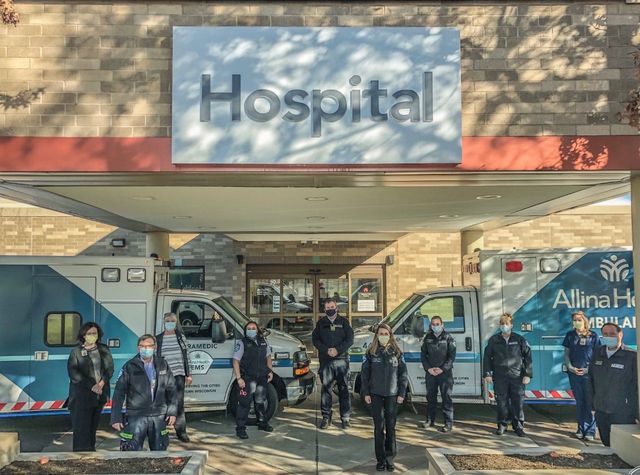
Our Emergency Operations Center strived to provide timely updates and information, which we did in traditional written and email form. In addition, to support a mobile and 24/7 workforce, we used technology to provide information through videos and update posts via a closed social media group for our employees.
During the start of the pandemic, a significant event took place in our area. We supported our local EMS and Public Safety partners as we experienced civil unrest as a result of the death of George Floyd. This time was demanding physically pandemic, the unrest and the summer increased our responses and it was emotionally demanding as we saw the toll both of these events took on our staff and our communities.
While COVID became a part of our regular responses, we moved into 2021 and experienced a workplace shooting at one of our clinics that our EMS staff responds to on a regular basis. The response to this event, the level of teamwork and dedication of our staff to providing exceptional care, highlights what makes Allina Health EMS one of the leaders in Minnesota EMS.
“Allina Health EMS providers show up everyday to be ready to respond to the needs of their community, whether it is a multi-vehicle crash on the freeway, a cardiac arrest of a grandparent or a new mom who is just scared and needs reassurance that her baby is okay. Our providers go above and beyond each day to take exceptional care of their patients and their communities. We are proud of everyone who supports the care of our communities and are looking forward to celebrating EMS Week 2021 with the team.” Susan Long, Vice President of Operations
EMS is important on many levels, but being there during a critical time of someone’s life is the most important to me. Being there to providing that voice of comfort to those who really need it, is the most rewarding part of all.
Kymberly Markgraf, EMT
Courage is being scared to death, but jumping in anyway. or Success is knowing another has breathed easier because of your help.
Kelly Pischke, Paramedic
Food and fellowship are the highlights of this year’s EMS Week at Allina Health EMS! Physical distancing guidelines prevented us from having our typical EMS gatherings last year and hampered our ability to celebrate our Centennial Year of Service. We are looking forward to recognizing our staff in everyday interaction but especially during their week with safety measures in place during meals and activities during the week